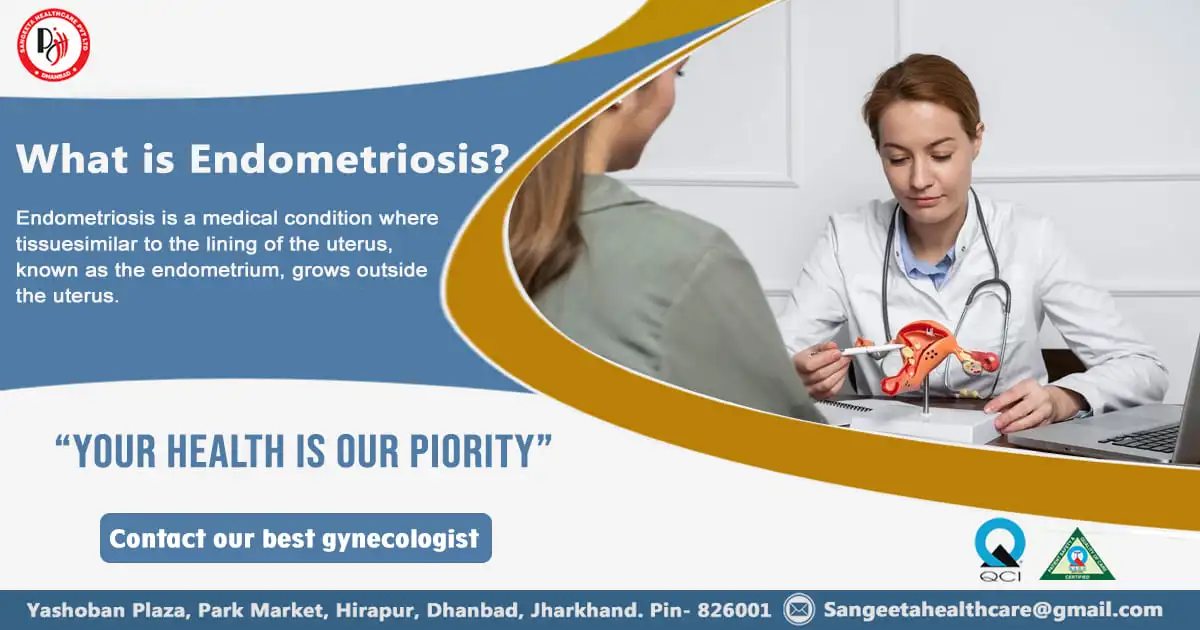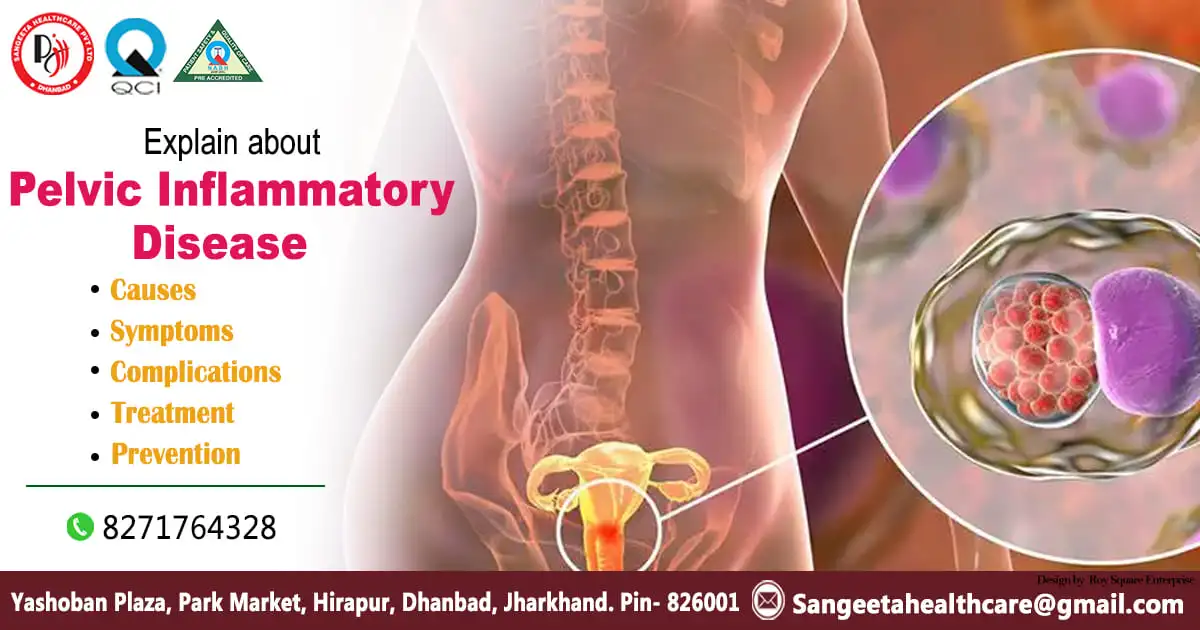Millions of women worldwide suffer with the persistent and frequently incapacitating disease known as endometriosis.Despite its prevalence, the awareness surrounding endometriosis remains limited, leading to delayed diagnoses and a lack of understanding about the impact it can have on a person’s life. In this blog post, we’ll delve into the intricacies of endometriosis, exploring its definition, symptoms, diagnosis, and the challenges faced by those living with this condition.

What is Endometriosis?
Endometriosis is a medical condition where tissue similar to the lining of the uterus, known as the endometrium, grows outside the uterus. This misplaced tissue can be found on the ovaries, fallopian tubes, bladder, and other pelvic organs. Unlike the normal endometrial tissue, the displaced tissue has no way to exit the body, leading to inflammation, pain, and the formation of scar tissue.
Symptoms:
The symptoms of endometriosis can vary widely, making it challenging to diagnose. Common symptoms include:
1. Pelvic Pain: Persistent and often severe pelvic pain is a hallmark of endometriosis. The pain may occur before or during menstruation, during sexual intercourse, or even during bowel movements.
2. Menstrual Irregularities: Women with endometriosis may experience heavy or irregular periods.
3. Painful Intercourse: Endometriosis can cause deep pain during sexual intercourse, which can significantly impact a person’s quality of life and relationships.
4. Digestive Issues: Some individuals may experience gastrointestinal symptoms such as bloating, constipation, or diarrhea, especially during menstruation.
Uncommon symptoms of endometriosis

However, what often goes unnoticed are the less common symptoms that can significantly impact a person’s life. Here, we will explore some of these uncommon symptoms, shedding light on the diverse ways endometriosis can manifest.
1. Chronic Fatigue:
While fatigue is a common complaint in many medical conditions, those with endometriosis often experience an overwhelming and persistent fatigue that goes beyond the usual tiredness associated with a hectic lifestyle. The chronic inflammation and hormonal imbalances caused by endometriosis may contribute to this profound fatigue, affecting daily activities and overall quality of life.
2. Painful Bowel Movements:
Endometriosis can involve the bowels, leading to pain and discomfort during bowel movements. Some individuals may experience diarrhea, constipation, or a mix of both, particularly around the time of menstruation. This symptom is often overlooked or attributed to other gastrointestinal issues, delaying the diagnosis of endometriosis.
3. Painful Urination:
Endometrial tissue may implant itself on the bladder or urinary tract, causing pain and discomfort during urination. This symptom can be mistaken for a urinary tract infection, leading to repeated courses of antibiotics without relief.
4. Painful Ovulation:
Women with endometriosis may experience sharp pain or cramping during ovulation, making it uncomfortable and sometimes debilitating. This symptom can be mistaken for normal menstrual cramps, resulting in a lack of recognition and appropriate management.
5. Pain Beyond the Pelvis:
While pelvic pain is a hallmark of endometriosis, the pain can extend beyond the pelvic region. Some individuals may experience pain in the lower back, thighs, or even radiating down the legs. This widespread pain can be challenging to connect with endometriosis, leading to a delay in diagnosis.
6. Cyclical Migraines:
Hormonal fluctuations associated with the menstrual cycle can trigger migraines in individuals with endometriosis. These cyclical migraines may be intense and challenging to manage, impacting daily functioning during menstruation.Understanding that endometriosis is not solely defined by pelvic pain and menstrual irregularities is crucial for timely diagnosis and effective management. By recognising the less common symptoms, individuals, healthcare providers, and the general public can contribute to a broader understanding of endometriosis. If you or someone you know is experiencing any of these unusual symptoms, seeking medical attention and advocating for comprehensive evaluation can make a significant difference in managing the impact of endometriosis on daily life. Let’s bring these lesser-known aspects of endometriosis into the spotlight and work towards a more informed and supportive approach to this complex condition.
Diagnosis:
Diagnosing endometriosis can be challenging, and it often takes several years from the onset of symptoms for a correct diagnosis to be made. Common diagnostic methods include:
1.Medical History and Symptom Assessment: A thorough discussion of symptoms, their duration, and their impact on daily life is crucial.
2. Physical Examination: A pelvic examination may be performed to check for abnormalities or signs of endometriosis.
3. Imaging Studies: Ultrasound or MRI scans may be conducted to identify the presence of endometrial tissue outside the uterus.
4. Laparoscopy:The most definitive method of diagnosis involves a surgical procedure called laparoscopy, where a small camera is inserted into the pelvic area to visualize and confirm the presence of endometrial tissue.
Challenges and Impact:
Endometriosis can have a profound impact on a person’s physical, emotional, and social well-being. Some of the challenges faced by those with endometriosis include:
1. Misunderstanding and Stigma: Due to a lack of awareness, there is often a misunderstanding of endometriosis, leading to stigmatization of those affected.
2. Delayed Diagnosis: The vague and diverse nature of symptoms contributes to delays in diagnosis, impacting treatment outcomes.
3. Fertility Issues: Endometriosis is a common cause of infertility, adding an additional layer of complexity and emotional distress for those trying to conceive.
Understanding Bowel Endometriosis:
Bowel endometriosis occurs when endometrial-like tissue implants itself on the bowel or adjacent structures. This can lead to various symptoms, including abdominal pain, bloating, changes in bowel habits, and discomfort during bowel movements. While these symptoms alone can significantly affect a person’s quality of life, the implications of bowel endometriosis extend to fertility concerns as well.
Impact on Fertility:

Adhesions and Scar Tissue:
Bowel endometriosis can cause the formation of adhesions and scar tissue in the pelvic region. These adhesions may distort the anatomy of reproductive organs, affecting the normal function of the fallopian tubes and ovaries. The resulting mechanical obstacles can impede the journey of the egg and sperm, reducing the chances of conception.
Inflammation and Hormonal Imbalance:
The inflammatory response triggered by endometriosis, particularly in the bowel, can create a hostile environment for reproductive organs. This chronic inflammation and hormonal imbalances may disrupt the delicate hormonal interplay necessary for a healthy menstrual cycle and successful conception.
Surgical Interventions:
In cases of severe bowel endometriosis, surgical interventions may be necessary to remove the affected tissue and alleviate symptoms. However, these surgeries can also pose a risk to fertility, as they may involve the removal of reproductive organs or the formation of additional scar tissue.
Navigating Fertility Challenges:
Early Diagnosis and Intervention:
Early diagnosis of bowel endometriosis is crucial for managing both symptoms and fertility concerns. Seeking medical attention when experiencing symptoms and undergoing comprehensive evaluations, including imaging studies and laparoscopy, can aid in timely intervention.
Collaborative Approach:
Managing bowel endometriosis and its impact on fertility often requires a collaborative approach involving gynecologists, gastroenterologists, and fertility specialists. A multidisciplinary team can tailor a treatment plan that addresses both the gastrointestinal and reproductive aspects of the condition.
Fertility Preservation Options:
For individuals facing fertility challenges due to bowel endometriosis, fertility preservation options such as egg freezing or in vitro fertilization (IVF) may be considered. These approaches aim to secure the possibility of conception before undergoing treatments that might impact fertility.Increased awareness, early diagnosis, and effective management are crucial for addressing the challenges posed by endometriosis. By fostering understanding and support, we can empower individuals with endometriosis to navigate their journey towards improved health and quality of life. It’s time to shed light on this often overlooked condition and work towards a future where those affected by endometriosis receive the care, understanding, and support they deserve.







